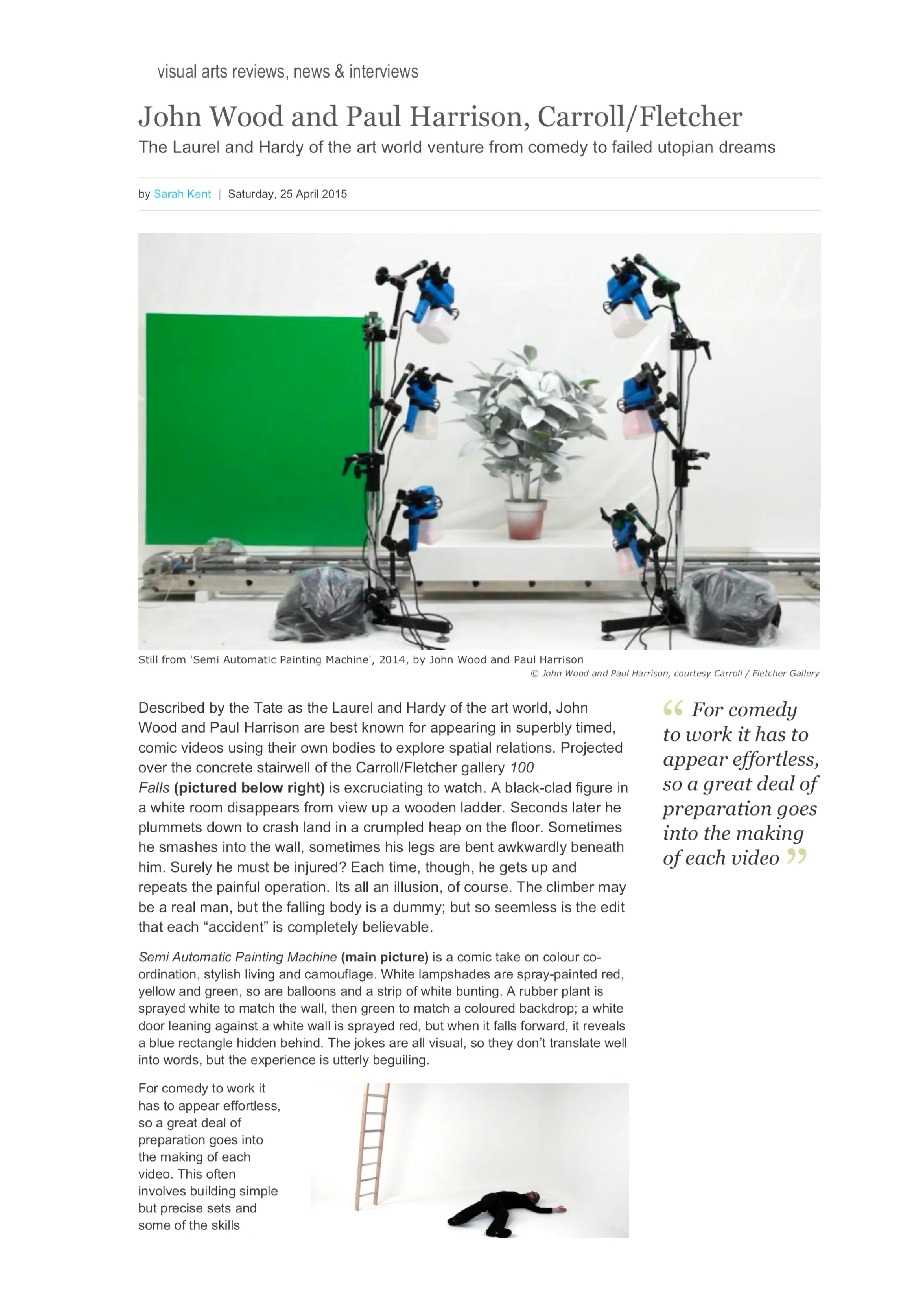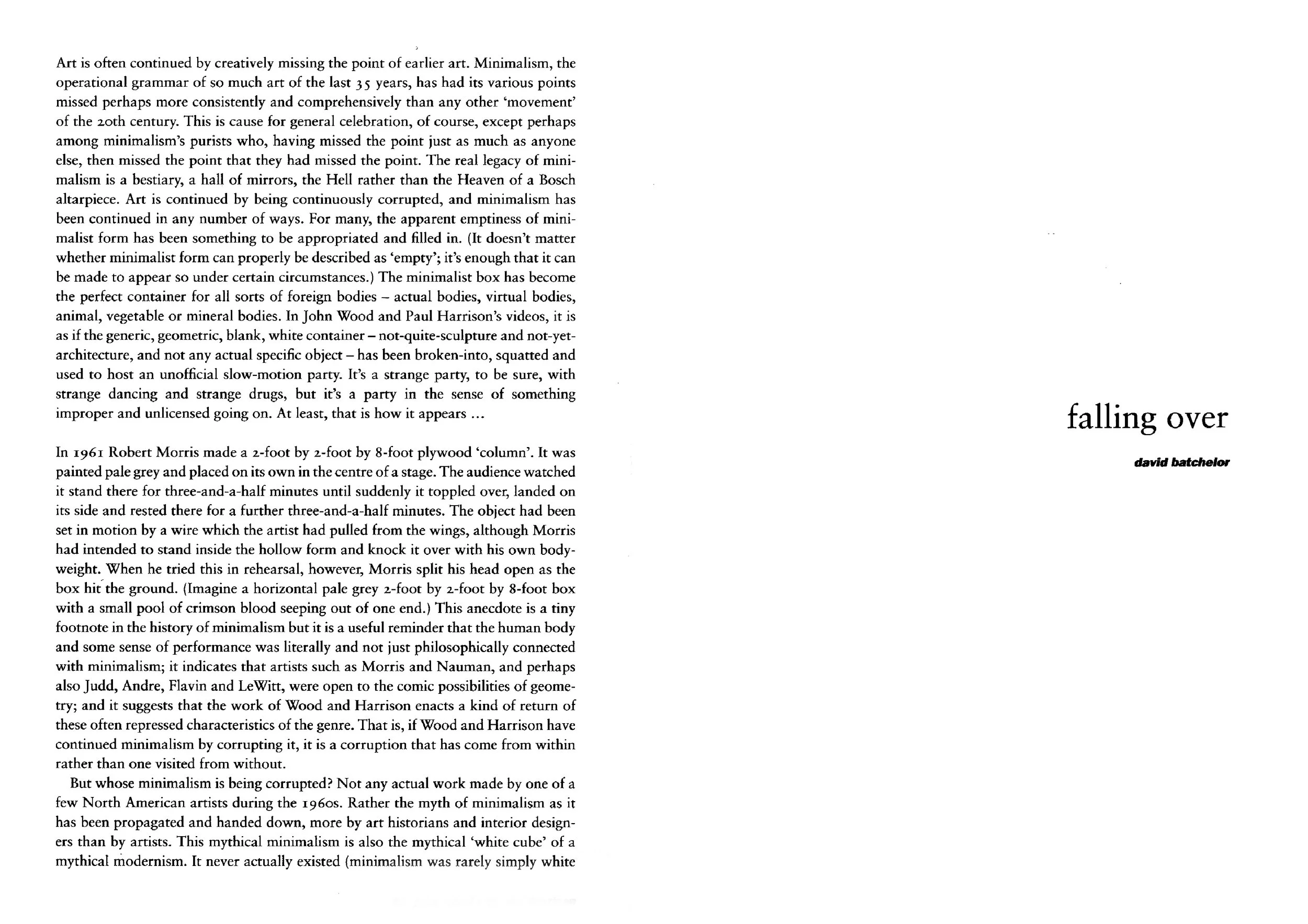Information
John Wood and Paul Harrison make things that move and things that don’t, things that are flat and things that are not, things that are mildly amusing and things that are definitely not.
They make works that form a kind of reference manual for how to do, make, build, or draw things that you probably never want to do, make, build, or draw. They do it for you. Even though you don’t need them to.
This attempt to compile an encyclopaedia of the everyday, started in 1993 after they met at art college.
John Wood (b.1969, Hong Kong) and Paul Harrison (b.1966, Wolverhampton)
Something basic feels revealed by Wood and Harrison’s irregular patterns of inexhaustible, developed and developing engagement. Curiously, meaning accumulates but is not imposed, not in terms of intention, or application, not the system of a formalist lexicon but a basic law that is also un-nameable, manifested through complex (brilliantly stupid) interaction, against the fog of normative usage, through the scrutiny and re-presentation, even, of the normal, the everyday – studied, isolated, plucked – phrased even: action and inaction, cause and effect, body and object. Life, huh. Like I say, these things happen.
Ian White
There isn’t an obvious word for what they do together. They are performance artists, of sorts. Their work is always a video piece, never a live show. Its look is minimalist. It partly suggests the controlled experiments of conceptual art – but equally the slapstick routines of physical comedy. “sculptural pratfalls” is about right
Tom Lubbock
Wood and Harrison treat their constructed, white-cube world as a microcosm of the world-at-large, the schematic nature of their actions creating a miniature theatre of endeavour that links to the Shakespearean idea of the ‘world as a stage’. But their experiments continuously exceed the politeness, the balance and poise and idealization expected of the white cube space and its spectators, and in this the falls, knocks and spillages seen in their work continuously forge pathways connecting the unreal realm of art to real life. The ‘double act’ serves as a compacted version [or equivalent] of human relations everywhere. More specifically, though, the object-mediated exchanges speak about the generation of art dialogue itself. The works examine the extent to which the very language of art is about a ‘conversation’ or exchange of language, one that permits a succession of ping pong balls firing into a corner or several watering cans dripping water on their heads to carry meaning. Though the absurdity of Wood and Harrison’s actions is easy to see, the schematic nature of their determined formal aesthetics make visible the everyday relevance of their endeavour.
Catherine Wood
Recent solo exhibitions include: Everything is Black and White, Gallery Vera Cortes, Lisbon (2021); Bored, Gallery Cristin Tierney, New York (2021); Words Made of Atoms, Gallery von Bartha, S-chanf, Switzerland (2020)
Recent group exhibitions include: Beano: The Art of Breaking the Rules, Somerset House (2021), London; L’effet Domino, Le 109, Nice (2020) Fresh Window, MUDAM, Luxemburg (2019); On Struggling to remain present when you want to disappear, OCAT Museum, Shanghai,China (2018)
Selected Solo museum shows: CAMH, Houston, USA / Mori Museum, Tokyo, Japan / Ikon Gallery, Birmingham, UK / Frist Centre, Nashville, USA / Kunstmuseum Thun, Switzerland / Chateau de Rochechouart, France / Ludwig Museum, Budapest, Hungary
Selected Group shows : ‘Art Now’, Lightbox, Tate Britain, London / ‘Slapstick’ Kunstmuseum, Wolfsburg, Germany / ‘Private Utopia’ British Council Touring, Japan / ‘Super 8’, Museum of Modern Art, Rio de Janeiro, Brasil / ‘Open Space’, ICC, Tokyo, Japan / ‘Mardin Bienali, Mardin, Turkey / ‘Made in Britain’, British Council Touring, China / ‘Richard of York Gave Battle in Vain’, Whitechapel Gallery, London, England / ‘You’ll never know’, Hayward Gallery Touring, UK / ‘New British Video’, MoMA, New York, USA
Selected screenings: MoMA, Queens, New York / MOCA, Los Angeles / Tate Modern, London / Centre Pompidou, Paris / Moderna Museet, Stockholm, Sweden / De Appel, Amsterdam, Netherlands / National Theatre, London
Selected Collections: Museum of Modern Art, New York / Tate, London / Arts Council Collection / British Council Collection / Centre Pompidou Collection / FNAC, France / Government Art Collection / Kadist Foundation, Paris / Ludwig Collection, Aachen
They are represented by Galeria Vera Cortês, Lisbon; Gallery von Bartha, Basel; Studio Trisorio, Naples and Cristin Tierney Gallery, New York








